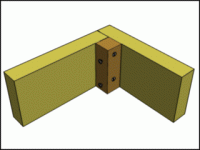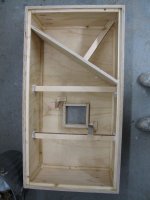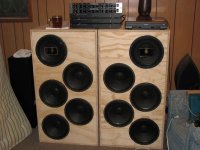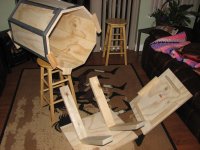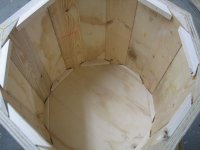I have started a simple two way project. My cabinet joints will be a ‘butt’ joint. I have a biscuit cutter and I am wondering if the use of biscuits would strengthen the corners? The reason I am asking is that I have not seen a project with biscuits. Any comments will be appreciated.
I use 2 inch by 2 inch softwood bracing in my cabinets.
I screw them to the panels.
Some people like to glue them as well.
This would be stronger than using biscuits.
If by bracing you mean, glued to the inside seam of the joint, this may not work for me. My panels have been cut and 2 x 2 material would displace too much volume. I could caIculate the volume of smaller bracing maybe 3/4 x 3/4. I have allowed volume for a shelf style brace horizontally and vertically.
Thanks for the quick reply.
Biscuits are really only for alignment. The glue is where all the strength comes from. If you want really strong corners use a glue block along all the edges to increase the surface area that the glue bonds.
That’s 2 replies for block bracing. The cabinet is 9.5” x 21.75” x 10” inside measurements for a volume of 1.196 cu. ft. Would block style bracing be more important then bracing with shelves front to back and top to bottom? I could eliminate one of the shelf braces giving me the needed volume for glue blocks.
you could use a couple of wood corner braces
Or a metal L corner brace (especially if you are going to be lining with heavy felt or something anyway.
An externally hosted image should be here but it was not working when we last tested it.
Or a metal L corner brace (especially if you are going to be lining with heavy felt or something anyway.
you could use a couple of wood corner braces
An externally hosted image should be here but it was not working when we last tested it.
Or a metal L corner brace (especially if you are going to be lining with heavy felt or something anyway.
That’s an option that would work within my plans.
thanks
If you don't want the cabinet's internal volume decreased, consider using triangular corner braces which displace only half as much air.
Sometimes using a dado blade in a table saw gives you a nice 'step' to position the wood for gluing a butt joint.
Now I often use an air brad-type finish nailer to hold things in position while the glue dries. I've used yellow carpenter's glue, epoxy, and lately PL2000 construction adhesive (which if very forgiving of woodworking errors and fills gaps nicely).
There have been commercial cabinets built entirely with hot-glue. Don't.
Sometimes using a dado blade in a table saw gives you a nice 'step' to position the wood for gluing a butt joint.
Now I often use an air brad-type finish nailer to hold things in position while the glue dries. I've used yellow carpenter's glue, epoxy, and lately PL2000 construction adhesive (which if very forgiving of woodworking errors and fills gaps nicely).
There have been commercial cabinets built entirely with hot-glue. Don't.
If you don't want the cabinet's internal volume decreased, consider using triangular corner braces which displace only half as much air.
Sometimes using a dado blade in a table saw gives you a nice 'step' to position the wood for gluing a butt joint.
Now I often use an air brad-type finish nailer to hold things in position while the glue dries. I've used yellow carpenter's glue, epoxy, and lately PL2000 construction adhesive (which if very forgiving of woodworking errors and fills gaps nicely).
There have been commercial cabinets built entirely with hot-glue. Don't.
Thanks, the dado is out, my saw is a 65 year old 8", and is not that accurate or powerful. I had a tour of 'Salk Loudspeakers' and they were using construction glue on some of their joints. I have been following instructions from a small guide from 'North Creek', they suggested carpenter's glue, which they called a hard glue. They did not suggest biscuits, that was my idea.
Last edited:
That’s 2 replies for block bracing. The cabinet is 9.5” x 21.75” x 10” inside measurements for a volume of 1.196 cu. ft. Would block style bracing be more important then bracing with shelves front to back and top to bottom? I could eliminate one of the shelf braces giving me the needed volume for glue blocks.
I find that Shelve bracing is overkill if most of the shelf is wood. All you need is a pont of intersection running along the walls to rase the panel harmonics. Not much mass is necessary to do this as long as there are strong connections between opposing walls.
We choose to have higher resonance panels because there isn't a lot of kinetic energy at high frequencies, Therefor there isn't enough energy to excite the mass of the open section of panel.
I have started a simple two way project. My cabinet joints will be a ‘butt’ joint. I have a biscuit cutter and I am wondering if the use of biscuits would strengthen the corners? The reason I am asking is that I have not seen a project with biscuits. Any comments will be appreciated.
If you have a biscuit <plate> joiner, you are way ahead of any kind of brace (and on bigger projects, you can biscuit the braces.)
A biscuit joint with glue can make a joint that approaches the strength of a single piece of material as seen here:
https://www.facebook.com/media/set/?set=a.2198606537629.119347.1621248869&type=3&l=6334890e9d
Screws are not needed unless there is a part you feel you may need to remove/
Paul
Thanks Paul
I was thinking biscuits had to be superior to a simple butt joint. (Enjoyed the link, nice build Paul) Thinking now of doing both biscuits and glue blocks, with single piece of wood or dowel front to back and side to side, too add additional strength.
For further information, the front and rear baffles are laminated .75” mdf and .5” Baltic ply.
I was thinking biscuits had to be superior to a simple butt joint. (Enjoyed the link, nice build Paul) Thinking now of doing both biscuits and glue blocks, with single piece of wood or dowel front to back and side to side, too add additional strength.
For further information, the front and rear baffles are laminated .75” mdf and .5” Baltic ply.
Thanks Paul
I was thinking biscuits had to be superior to a simple butt joint. (Enjoyed the link, nice build Paul) Thinking now of doing both biscuits and glue blocks, with single piece of wood or dowel front to back and side to side, too add additional strength.
For further information, the front and rear baffles are laminated .75” mdf and .5” Baltic ply.
Do yourself a favor: there's no way to do glue blocks without screws on the inside. This only complicates the perfect alignment when using the joiner. The blocks must be perfectly aligned or you will have to critically sand before all the glue.
As with most things, getting someone to get the parts exact before you start will help immensely. Exactly sized parts cut with careful joining <given the built-in slip> make for enclosures that scare some.
P
Do yourself a favor: there's no way to do glue blocks without screws on the inside. This only complicates the perfect alignment when using the joiner. The blocks must be perfectly aligned or you will have to critically sand before all the glue.
As with most things, getting someone to get the parts exact before you start will help immensely. Exactly sized parts cut with careful joining <given the built-in slip> make for enclosures that scare some.
P
Oh! Wait ! I am wrong.
You could do the cabinet and glue/clamp with biscuits and then add and clamp corner braces from the top.
P
A little advice from an old cabinetmaker .... footballs are easy, quick, and used waaaay too much. I'm old enough to remember when they first invented this ("lamelo")
.... used to work for a high end shop in Chicago that did mostly restaurant interiors. For years they joined bar tops with dowels ... along came the lamelo and they gave it a shot on one job. About six moths later you could see every football in the millwork faces ... tops, soffit panels, etc.
The biscuits are so hard that when the surrounding panels, or whatever material is used as a substrate moves (shrinks), the biscuit stays at the same dimensional thickness. The glue around the biscuit further solidifies it's mass and adds hardness. They will telegraph their presence to the surface over time. Dowels will not. That company never used biscuits again.
Not advocating dowels in you case work here ... corner bracing, as has been illustrated by others, would be my first choice, too. A simple chamfered ripping would do wonders for strength. Assemble the joint ... let it set and add in the bracing later. Plenty of glue and a couple tacks to hold it.
.... used to work for a high end shop in Chicago that did mostly restaurant interiors. For years they joined bar tops with dowels ... along came the lamelo and they gave it a shot on one job. About six moths later you could see every football in the millwork faces ... tops, soffit panels, etc.
The biscuits are so hard that when the surrounding panels, or whatever material is used as a substrate moves (shrinks), the biscuit stays at the same dimensional thickness. The glue around the biscuit further solidifies it's mass and adds hardness. They will telegraph their presence to the surface over time. Dowels will not. That company never used biscuits again.
Not advocating dowels in you case work here ... corner bracing, as has been illustrated by others, would be my first choice, too. A simple chamfered ripping would do wonders for strength. Assemble the joint ... let it set and add in the bracing later. Plenty of glue and a couple tacks to hold it.
biskits
What puppet says. This process was invented to adapt to the weakness of composite materials, especially chipboard, which cannot be splined or tongue and grooved like real, meaning REAL, wood. Too weak. Crappy. Not good. Bad.
This DOES apply to the latter day particle board, MDF. Use plywood. It isn't dead yet.
Sorry, just my experience. Dowels rule.
What puppet says. This process was invented to adapt to the weakness of composite materials, especially chipboard, which cannot be splined or tongue and grooved like real, meaning REAL, wood. Too weak. Crappy. Not good. Bad.
This DOES apply to the latter day particle board, MDF. Use plywood. It isn't dead yet.
Sorry, just my experience. Dowels rule.
Correct me if i'm wrong, but if you're struggling to add bracing due to your internal volume already being fixed, could you just add some stuffing to make the box "look bigger" to the driver? Then you've given yourself some extra room to add whatever bracing you feel is required....? Unless you've already fixed how much, if any, stuffing your using. If someone more experienced could verify/correct my idea that would be useful as i'm just a novice 
My biscuit joiner sits on the shelf. I use cleats (corner blocking) exclusively and I use square rather than chamfer strips because I install the cleat on one of the panels first. This allows for perfect alignment when you assemble your box. It is also very quick. It allows you to assemble all but the back piece with inside (blind) fasteners. I use a Brad nailer only. I find screws are slow, cumbersome and unnecessary. I even do it for test boxes. In this case I decided to fit the baffle last so in this case there are exposed fasteners on the front but the idea is the same.
The apparent bulging of the box is just the camera.
The apparent bulging of the box is just the camera.
Attachments
Another trick for when the box is not square is to use the tape and roll method and add the cleats later. Ripping down 2X4's to get a snug fit is a bit of a job though. The top and bottom pieces are just for a bit more gluing surface for the front and back so I wasn't worried about them too much.
Here is the build thread for more pics on how it's done.
http://www.diyaudio.com/forums/multi-way/178459-flying-v-cal-style.html
Here is the build thread for more pics on how it's done.
http://www.diyaudio.com/forums/multi-way/178459-flying-v-cal-style.html
Attachments
- Status
- This old topic is closed. If you want to reopen this topic, contact a moderator using the "Report Post" button.
- Home
- Design & Build
- Construction Tips
- Help With Joints
